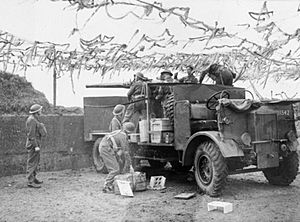Fort Horsted facts for kids
Fort Horsted is an old fort located in the Horsted Valley, near Chatham, Kent, England. It was built in the late 1800s and was one of six forts made to protect the important Chatham Dockyard from attacks.
Plans for the fort first came up in 1860, but building it was put off to save money. Only forts along the River Medway were built then. It wasn't until the mid-1870s that new plans were approved. These plans included building a special facility at Borstal, Rochester, to provide workers for building a line of four forts: Fort Borstal, Fort Bridgewood, Fort Horsted, and Fort Luton. Construction of Fort Horsted began in 1879 and finished in 1889, after some delays.
Contents
Building Fort Horsted
This fort was built almost entirely from concrete. The outside was covered with chalk and earth, so you couldn't see the concrete, except at the back of the fort. It also had a deep ditch around it. This ditch was protected by special underground passages called counterscarp galleries.
Weapons and Defenses
When Fort Horsted was first planned, it was meant to have big, fixed guns that stayed in one place. However, by the time it was finished, military thinking had changed. Instead of fixed guns, the fort would have been armed with movable field artillery only if there was a real threat.
If an invasion happened and Chatham Dockyard was attacked, extra defenses would have been added. These would include trenches and other gun positions around the forts. In fact, during military exercises in 1907, these kinds of defenses were likely set up.
Fort Horsted in the World Wars
By 1910, Fort Horsted was considered old-fashioned. However, it still played a role in Chatham's defenses during both World War I and World War II.
In World War I, brick structures and a small concrete shelter called a pillbox were built on the fort's walls. Early types of anti-aircraft guns were also installed there. These might have been 12-pounder coastal defense guns, set up to shoot at planes.
What's in a Name?
The fort was named after a small local village called Horsted. People believe that Horsted might have been named after a legendary Saxon warrior named Horsa. Legend says Horsa was killed nearby at Aylesford while fighting against the Britons.
Fort Horsted Today
Fort Horsted is still mostly intact today. It is currently used as a business park. While it's in good shape, its use for businesses has led to some new buildings and changes. This means some of the fort's original parts and features have been lost.


